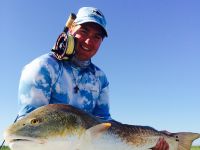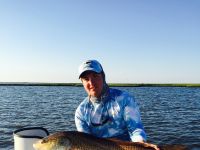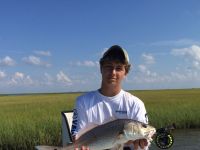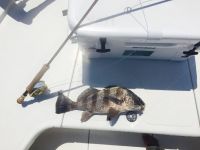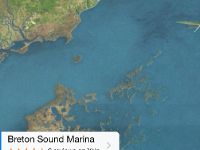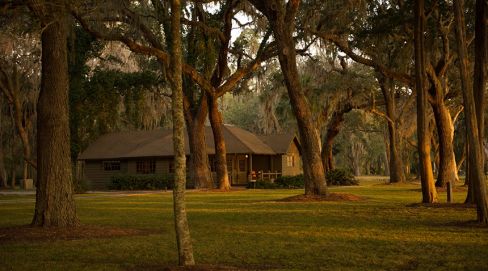Good Redfish, Drum, Sheepshead, and tripletail action right now as its heating up. Wear long sleeve shirts, pants, buffs, and sun hats to stay covered. Also wear breathable clothes to stay cool.
- When winds are stronger than 5 MPH, visibility through the water is highly impacted with the exception of the shorelines the wind originates from, so try to fish those banks. Also, when the wind is any greater than 5 MPH, tailing and fish movement becomes less obvious and happens less often. Try to fish days that have no wind. BRING BUG REPELLENT FOR THE HORSEFLIES.
- Lagoons and ponds close to the marina are now choked up with vegetation and leave little open water for seeing fish. Smaller fish are residing in these ponds as well with the occasional larger fish. Many large fish are still insho View more...Good Redfish, Drum, Sheepshead, and tripletail action right now as its heating up. Wear long sleeve shirts, pants, buffs, and sun hats to stay covered. Also wear breathable clothes to stay cool.
- When winds are stronger than 5 MPH, visibility through the water is highly impacted with the exception of the shorelines the wind originates from, so try to fish those banks. Also, when the wind is any greater than 5 MPH, tailing and fish movement becomes less obvious and happens less often. Try to fish days that have no wind. BRING BUG REPELLENT FOR THE HORSEFLIES.
- Lagoons and ponds close to the marina are now choked up with vegetation and leave little open water for seeing fish. Smaller fish are residing in these ponds as well with the occasional larger fish. Many large fish are still inshore and should remain there. A 30-45 minute boat ride will guarantee sighting of fish. Fish the outer islands of the area. There is no vegetation in the water there and oyster beds cover the majority of the water.
-REDFISH: On rides to desired locations, watch the shorelines closely as you pass for tailing fish. In channels and more open water, a tailing redfish may be anywhere from 10-40 pounds. Large schools of 30-40 pound redfish may be seen feeding under a flock of seagulls or thrashing on the surface of the water. On a good Tide with no or little wind, you can see them easily. Otherwise fish small ponds and lagoons with water at most 1 and 1/2 feet deep. Look for tailing redfish on the calm winded banks. If the water is too choppy redfish will not tail. Redfish are most active during a heavy rising tide and most any falling tide. Early in the morning and late in the evening are the hottest times to see Redfish. If you do not see a fish, whether under the water or tailing, wishin 15 minutes of being in one spot, try the next spot. Cast your fly without 3 feet of their face and start stripping immediately. As they give chase, strip faster and faster until they eat your fly. Strip set and let them run. Be sure to wait for a tailing Redfish to come near your fly before you start stripping. Put the fly 1 foot Infront of cruising redfish and strip quickly. Continue until they see and chase your fly.
-BLACK DRUM: Large Drum can be found now on some of the outcropping islands in saltier water over any oyster beds. Black drum crush and eat oysters for sustinence with large jaws in the back of their mouth. Schools of 10-100 Drum can be found tailing and floating near shallow Oyster beds. Fish the outlying islands. On a rising tide, look for tailing Drum near the banks along the grass line. Drum will tail facing into the grass or straight down into the mud. Cast as close to their face as you can. On a slack tide, look for schools of 5-40 Drum sitting stationary on the shorelines inside lagoons. Redfish may mixed in. On a failing tide, Scan across the entirety of the lagoon, and target the most sense grouping of tails for the best opportunity. Your fly MUST be on the bottom for Black drum to notice it. Use a heavy fly with hydrodynamic materials to sink quickly. Black drum will tail facing straight up and down with their tail facing directly upwards while they suck the oyster from the mud. Cast your fly directly onto them and let it sink for 3 seconds as they reorient themselves in the water. Strip long and very slow strips and strip set when you feel tension. Avoid casting over and past them as you will foul hook their backs. Black Drum will not tail as often or at all if the wind is higher than 6-8 MPH.
-SHEEPSHEAD: Sheepshead can be found in large numbers in the ponds closer into land. Take a 5 minute ride from the marina to any of the lagoons and ponds and look for sheepshead in the areas not swallowed by vegetation. Water near the banks and any water that is less than 6 inches deep shouldn't have vegetation in it right now. Small, realistic crab patterns with rubber legs are your best bet at catching one, and your presentation must be precise. Do not get too close to the fish, but don't expect to see it before it's too late. It's not called the Marsh Permir for nothing!
-TRIPLETAIL: Tripletail can be found on the outlying island in channels as of now. They can also be found floating on their sides next to stationary objects such as crab bouys and any other floating debris or object that is stationary.
For Fisherman with Kayaks or paddle boards, be sure the have all safety equipment with you. No more than a 20 minute paddle can get you into small channels and ponds that vary from 6-12 inches deep. Fish the shallower water for sheepshead and Redfish varying in size from 12-20 inches. Early morning and late in the evening will be the times where the fish are most active. Good rising tides and most any falling tide will produce tailing fish.
Do not go out if:
Winds are stronger than 7 MPH
There is heavy cloud coverage
Depending on the solunar calendar, avoid slack tides. (Good Solunar activity will provide fish even on a slack tide.)
You do not have the proper safety equipement and licensing for your vessel.
If the water is hotter than 100 degrees, you may have trouble reviving your fish. On days like this fish the morning bite.
Never go out without sunscreen, Bug repellent, at least 2 days worth of freshwater, and adequate food.



